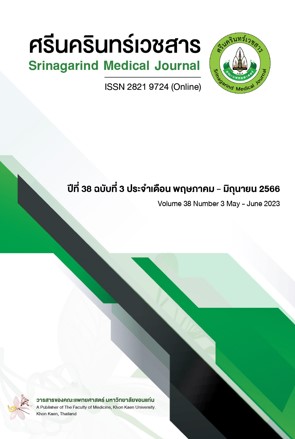Development of Specimen Retrieval Bag for Laparoscopic Surgery
Keywords:
specimen retrieval bag, laparoscopic surgeryAbstract
Background and Objective: Endoscopic surgery was accepted in the medical field for the effectiveness of the treatment results but requires the complex tools, expertise of surgeon and accessories such as specimen retrieval bag for reduce contamination of secretion which is expensive and imported affect higher costs. The surgeon need to make a wide incision for easy removing the bag. This innovative development aimed to reduce surgical wound infections, reduce costs and ensure surgical team personnel satisfaction.
Methods: Initially, food plastic bags were used. Found problem about sticking together of the bag mouth while using. Therefore changed to a clear ziplock plastic bag, found that the ziplock of the bag mouth was closed when it entered the abdominal cavity. At present, turn the bag inside out. so that the bag mouth is not pinched found it convenient. Working test by bursting test, tensile test, bursting strength, basis weight test and the successful use of innovation, it was found that it passed all tests.
Results: Applied in 2,750 patients, found that the surgical wound infection rate was 0.02%, the average production cost was 16.70 baht per bag, after being applied for 3 years and 3 months, the cost savings was 2,154,075 baht, the average satisfaction score was highest. (4.87±0.52)
Conclusions: Biopsy bags are innovative and efficient due to low cost and does not infect. They can be use in any surgery.
References
Johnson N, Barlow D, Lethaby A, Tavender E, Curr L, Garry R. Methods of hysterectomy: systemic review and meta-analysis of randomized controlled trials. BMJ 2015;330:1478-85. doi.org/10.1136/bmj.330.7506.1478.
Prathanvanich P. Single incision laparoscopic cholecystectomy: SILC. Health Bangkok 2016; 4(2): 6-8.
Stavroulis A, Memtsa M, Yoong W. Methods for specimen removal from peritoneal cavity after laparoscopic excision. TOG 2013;15:26-30. doi.org/10.1111/j1744-4667.2012.00148.
Donabedian A. edited by Bashshur R. An Introduction to Quality Assurance in Health Care. New York: Oxford University Press, Inc, 2003.
Food Network Solution. Polyvinyl Chloride. [cited November 5, 2022]. Available from: http://www.foodnetworksolution.com
Textbook Board, Faculty of Nursing Science, Mahidol University, In: Renu Artsalee, Editor. Operating Room Nursing, Bangkok: Ruangtham Printing House, 1991:86-104.
Food Network Solution. Material and packaging testing. [cited November 3, 2022]. Available from: http://www.foodnetworksolution.com
Downloads
Published
How to Cite
Issue
Section
License
Copyright (c) 2023 Srinagarind Medical Journal

This work is licensed under a Creative Commons Attribution-NonCommercial-NoDerivatives 4.0 International License.




